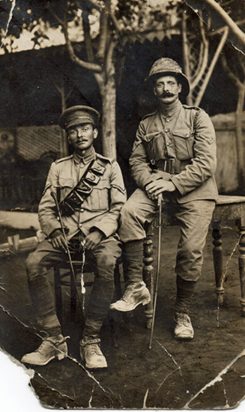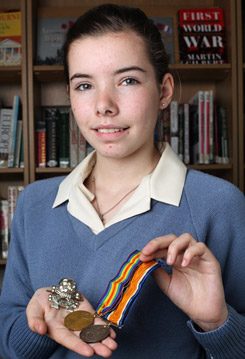Europeana Collections 1914–1918
Digitization Project on Everyday Culture

400,000 objects from European national libraries and archives have been digitized for a project on everyday culture during the First World War. They now form part of the virtual collection in one of Europeana’s thematic portals.
To mark the one hundredth anniversary of the start of the First World War, some 400,000 outstanding contemporary documents from the libraries and archives of eight European countries will be made available online via europeana.eu. This is the impressive outcome of Europeana Collections 1914–1918, a European Commission-funded international digitization project.
It all started in 2011 with twelve partners – most of them national libraries – and a clear objective: “Our project shows what everyday life was like during wartime, both in the trenches and on the home front”, explains project coordinator Thorsten Siegmann from Berlin’s state library. “In other words, it’s mainly about things with which normal people would have come into contact between 1914 and 1918: like trench newspapers and flyers, as well as edifying literature and cookbooks.”
Crossing the boundaries of archiving traditions
Trailer: Europeana 1914-1918 film collection Brothers George Brain, 10th Battalion, Sherwood Foresters, and Harry Brain, Queen's Own Oxfordshire Hussars in Havrincourt, France.
| © Keith Brain
Communication is clearly the key in an international project of this magnitude. “These are complex processes involving a large number of people: from librarians and technical service providers to platform operators. Probably the greatest challenge was to ensure that all the partners involved used the same categories, thus making it easy for users to find the content in which they are interested”, explains Thorsten Siegmann. “After all, we are working not only in different languages but also with different archiving traditions and thus with different ways of viewing library holdings.”
Brothers George Brain, 10th Battalion, Sherwood Foresters, and Harry Brain, Queen's Own Oxfordshire Hussars in Havrincourt, France.
| © Keith Brain
Communication is clearly the key in an international project of this magnitude. “These are complex processes involving a large number of people: from librarians and technical service providers to platform operators. Probably the greatest challenge was to ensure that all the partners involved used the same categories, thus making it easy for users to find the content in which they are interested”, explains Thorsten Siegmann. “After all, we are working not only in different languages but also with different archiving traditions and thus with different ways of viewing library holdings.”The first step was to agree on a metadata format and on criteria for the selection of documents. This involved identifying genuinely outstanding objects in the collections and securing particularly fragile works or those at risk of being destroyed.
Different languages in the metadata, too
War chronicle No 85, France Deutsches Filminstitut – DIFOne essential criterion for selection was also the question of copyright. “Without permission we are only able to digitize copyright-free works, that is to say works whose authors or creators have been dead for at least 70 years. This is by no means the case for all materials relating to the period 1914 to 1918”, says Siegmann. “When it comes to particularly outstanding documents, it is of course possible to seek permission from all the authors or creators of a work. Given that we are dealing with more than 400,000 documents, however, this is only possible in isolated cases.”
Linguistic diversity posed a further challenge: “The metadata provided by our project partners comes in different languages. As a rule, the participating libraries have monolingual catalogues.” To allow digitized objects to be used irrespective of their language, 50 central themes were identified and then labelled using a multilingual classification system. “Anyone who enters ‘trenches’ in English in the thematic portal will also find objects about this theme in other languages.”
Three projects in one portal
 Chloe Coules with her great-great-grandfathers' medals and 'Death or Glory' Boys cap badge.
| © Giles Davies
The results of the digitization project are incorporated into Europeana, Europe’s virtual library, europeana.eu thematic portal combining three major projects. One of these is the European Film Gateway 1914, for which over 660 hours of film material from 21 European archives were digitized.
Chloe Coules with her great-great-grandfathers' medals and 'Death or Glory' Boys cap badge.
| © Giles Davies
The results of the digitization project are incorporated into Europeana, Europe’s virtual library, europeana.eu thematic portal combining three major projects. One of these is the European Film Gateway 1914, for which over 660 hours of film material from 21 European archives were digitized.Furthermore, the portal also presents the fruits of the Europeana-1914-1918 family history roadshows that have already been held in twelve countries. On specific dates, private individuals are invited to bring their personal keepsakes – such as letters, postcards or diaries – into libraries so that they can be digitized directly on site. 90,000 digitized copies of personal mementos and documents are already online, and similar family history roadshows are planned in five additional countries.
In other words, the content contributed by libraries to europeana.eu will continue to grow. “To date, only two thirds of our collections can be viewed”, says Thorsten Siegmann. The portal’s technological development is also not yet complete. So far, content is arranged by document type, theme or wartime site. “We are working on offering many more categories, which will make it easier to search for specific content. After all, the portal is not supposed to benefit only researchers – our aim is to give anyone interested easy access to information about everyday life during the First World War.”